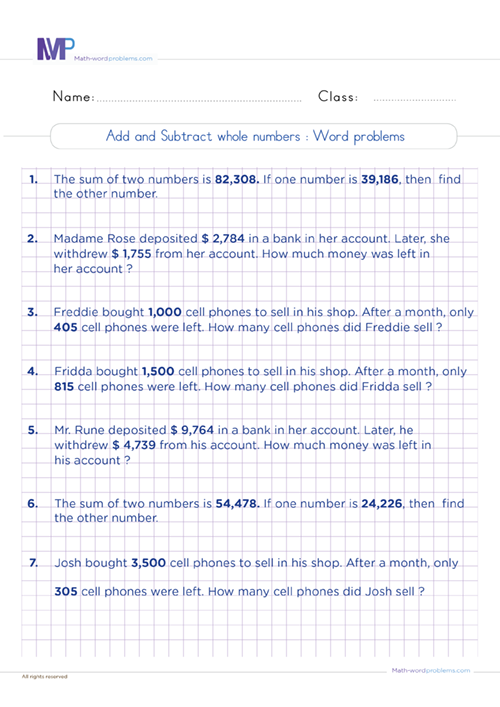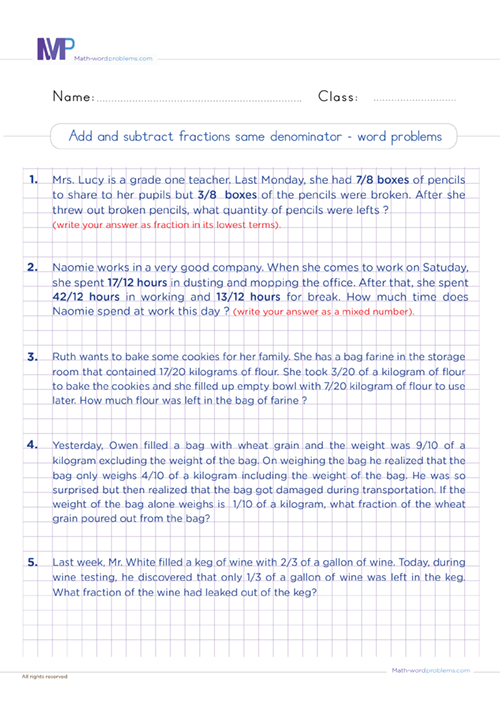 How to add and subtract whole numbers word problems
How to add and subtract whole numbers word problems
Do you know how to add and subtract whole numbers word problems, including larger digit numbers? If no! Then here is a short and simple step-by-step guide on how to do it.
We know that sixth graders often encounter and do more complex word problems involving addition and subtraction of whole numbers. For this reason, we designed this fantastic, straightforward guide that will significantly improve their word problem-solving mathematics skills.
Hence your kids will be able to tackle any complicated word problems on addition and subtraction of whole numbers.
Steps to solve addition and subtraction of whole numbers word problems
Here are easy steps to solve addition and subtraction of whole numbers word problems.
After examining the difficulties, kids face when solving whole numbers word problems, we have designed the best step-by-step guide to help them overcome such difficulties.
In addition, we have added a few enriching examples for you to see how magical these steps below work.
Step 1: IDENTIFY
In this step, figure out what you need to do (whether to add or subtract) and then filter the unimportant information from the given word problem.
-
If it is an addition word problem, you will see at least one of the keywords below in the word problem.
- Add
- Plus
- More
- Total
- Increase
- Together/ Altogether
- Combined
- Sum
- Grow
- Join
- Both
- Etc.
-
Now when moving on to subtraction word problems, some of the keywords you’ll come across in the word problem are:
- Less
- Minus
- Take away
- Left
- Decrease
- Difference
- Remain
- Change
- How many more
- Subtract
- Fewer
- Deduct
- Etc.
Note: One key Element for learners to understand is that they should not always rely on keywords alone. That is to say; the same keyword can have different meanings in different word problems.
For this reason, we reiterate on the importance of reading the question very carefully to understand the situation that the word problem is describing, then figure out exactly which operation to use
Step 2: STRATEGIZE
How will you solve or tackle the problem?
- As mentioned above, from the keyword(s) in the word problem, you will know if you need to add or subtract.
- Remember, you must not depend only on keywords. Instead, try to read and understand the situation that the problem is describing.
- After knowing which operation you will perform, construct short expressions/sentences representing the given word problem.
Step 3: SET UP OR BEGIN
Here, you are supposed to write down a numerical expression representing the information in the word problem.
Step 4: PROVIDE A SOLUTION
Now, after writing down the math problem (numerical expression), you can go ahead and solve the problem using any method of your choice. Note that the column method for addition and subtraction is always preferable.
Always remember to include the unit of measurement, if any.
Step 5: CHECK YOUR WORK
Finally, ask yourself this question. Does my answer make sense? If “YES”, you are done. If “NO”, go back to step 1 and start all over again.
Examples on how to add and subtract whole numbers word problems
Example one: Right here is an example on how to solve addition word problems using the steps described above
Step 1: first, the important numbers here are 156 and 25. The keyword(s) found in the word problem is “more.”
Step 2: Next, how will you solve the problem? You see, from the situation that the word problem is describing and the keyword found in it, you need to carry out an addition operation.
Then, form short expressions/sentences to represent the given word problem.
- Number of mangoes that Marcy picked = 156.
- Number of more mangoes that Boris picked = 25.
- Therefore, the number of mangoes Boris picked = the number of mangoes Marcy picked + the number of more mangoes Boris picked.
Step 3: Now, write down a numerical expression to represent the bolded sentence in step 2 above:
156 + 25 = ?
Step 4: From step 3 above, arrange the values so their place values will line up (i.e., the column method). Then, go ahead and add the values. Always remember to add the unit of measurement to your final answer, if any.
So, Boris picked 181 mangoes
Step 5: Finally, check out your work to know if the answer makes sense, i.e., by estimating the numbers and calculating mentally. If the answer is so close to the one you have, then your answer is correct but if the answer is not close to your answer, go back to step 1.
Example two: here is an enriching example of a subtraction word problem for grade 6.
Step 1: First, the important numbers here are 126 and 568. You see that the keyword(s) in the word problem is “how many more.”
Step 2:Now, how will you solve the problem? As you can see, the situation that the word problem describes and the keyword(s) found in the word problem calls for you to use a subtraction operation.
Next, construct short expressions/sentences to represent the given word problem.
- Number of sacks that he sold to the retailer = 568.
- Number of sacks that he sold to his neighbor = 126.
- Therefore, the number of more sacks he sold to the retailer than his neighbor = the number of sacks he sold to the retailer – the number of sacks he sold to his neighbor.
Step 3:Then, write down a numerical expression to represent the bolded sentence in step 2 above:
568 – 126 = ?
Step 4:
So, he sold 442 more sacks of wheat to the retailer than his neighbor.
Step 5: Finally, check out your work to know if the answer makes sense, i.e., by estimating the numbers and calculating mentally. If the answer is so close to the one you have, then your answer is correct but if the answer is not close to your answer, go back to step 1.






